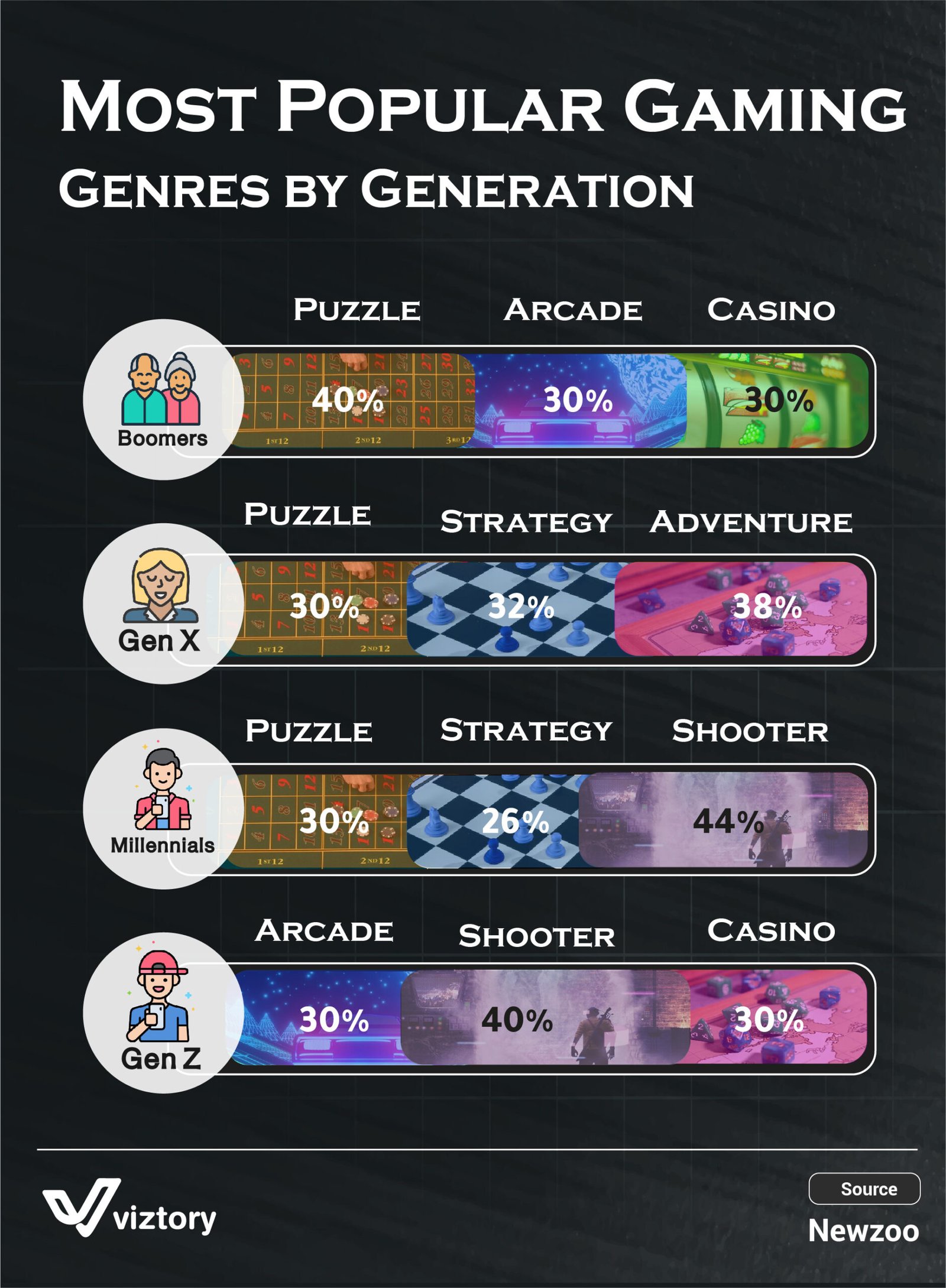Most Popular Gaming Genres by Generation
-
Jan, Tue, 2025
The gaming industry has evolved into a global phenomenon, transcending age groups and preferences. This chart highlights the most popular gaming genres across generations, showcasing how technological advancements and cultural influences have shaped gaming habits over time.
Gaming Preferences by Generation
Boomers (1946–1964):
- Puzzle Games (40%): Boomers favor mentally stimulating games that promote problem-solving and relaxation. Popular titles include crossword puzzles and Sudoku adaptations.
- Arcade Games (30%): Nostalgia plays a role here, with Boomers enjoying classics like Pac-Man and Space Invaders.
- Casino Games (30%): Virtual card games and slot machines replicate the thrill of physical casinos.
Gen X (1965–1980):
- Adventure Games (38%): This generation values immersive storytelling and exploration, often influenced by games like The Legend of Zelda.
- Strategy Games (32%): Strategic thinking and planning dominate, with favorites like Chess and Civilization.
- Puzzle Games (30%): Puzzle-solving remains a staple, blending fun and cognitive engagement.
Millennials (1981–1996):
- Shooter Games (44%): Competitive gaming, driven by titles like Call of Duty and Counter-Strike, appeals to this tech-savvy group.
- Puzzle Games (30%): Casual games like Candy Crush continue to engage Millennials during downtime.
- Strategy Games (26%): Real-time and turn-based strategy games attract players who enjoy tactical decision-making.
Gen Z (1997–2012):
- Shooter Games (40%): Fast-paced, multiplayer games like Fortnite dominate, driven by social interaction and cutting-edge graphics.
- Arcade Games (30%): A resurgence of arcade-style games offers quick, engaging experiences.
- Casino Games (30%): Virtual casino games provide entertainment and a taste of chance-driven excitement.
The Role of Technology in Gaming Evolution
Technological advancements have played a pivotal role in shaping gaming preferences:
- High-Performance Graphics: Improved hardware enables lifelike visuals, particularly in shooter and adventure games.
- Mobile Gaming: Smartphones have made puzzle and arcade games accessible anytime, anywhere.
- Online Multiplayer: Enhanced connectivity fosters social gaming, a key driver for Millennials and Gen Z.
- Artificial Intelligence: AI enhances gameplay experiences, especially in strategy and adventure genres.
Cultural and Social Influences
Gaming preferences also reflect generational experiences:
- Boomers: Influenced by traditional games and early arcade systems.
- Gen X: Grew up with the first wave of home consoles, valuing deep, story-driven experiences.
- Millennials: The rise of eSports and competitive gaming shaped their choices.
- Gen Z: Immersed in a digital-first world, they gravitate toward multiplayer and visually stunning games.
Conclusion
The diversity in gaming preferences across generations demonstrates how technology and cultural influences drive innovation in the gaming industry. From nostalgic arcade games to high-octane shooters, each generation finds joy and connection through gaming. As technology continues to evolve, the industry is set to deliver even more tailored experiences for players of all ages.

